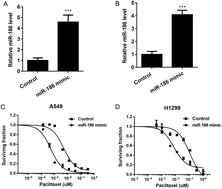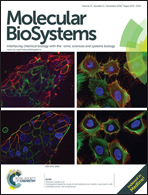miR-186 regulates chemo-sensitivity to paclitaxel via targeting MAPT in non-small cell lung cancer (NSCLC)†
Abstract
miR-186 has been reported to be implicated in tumorigenesis and chemoresistance in a few cancer types. However, its role in regulating chemoresistance has not been investigated in non-small cell lung cancer (NSCLC). To examine the effects of miR-186 on chemosensitivity in NSCLC, an miR-186 mimic and inhibitor were transfected, followed by CellTiter-Glo® assay in NSCLC cell lines. Western blot and luciferase assay were performed to investigate the direct targeting of miR-186. A xenograft mouse model was used to examine the in vivo chemosensitizing function of miR-186. We found that overexpression of miR-186 sensitized A549 and H1299 cells to paclitaxel, whereas inhibition of miR-186 conferred resistance in these cells. MAPT was the direct target of miR-186 which was required for the regulatory role of miR-186 in chemoresistance. This chemosensitizing function was partially due to the induction of the p53 mediated apoptotic pathway. The miR-186 mimic enhanced the tumor growth inhibitory effects of paclitaxel in A549 xenografts. In addition, miR-186 was found to be down-regulated in NSCLC patients who were chemoresistant and this down-regulation was associated with poor survival. Taken together, our study demonstrated that miR-186 regulates the chemoresistance of NSCLC cells by modulating the MAPT expression level both in vitro and in vivo. miR-186 may represent a new therapeutic target for the improvement of the clinical outcome in NSCLC.


 Please wait while we load your content...
Please wait while we load your content...